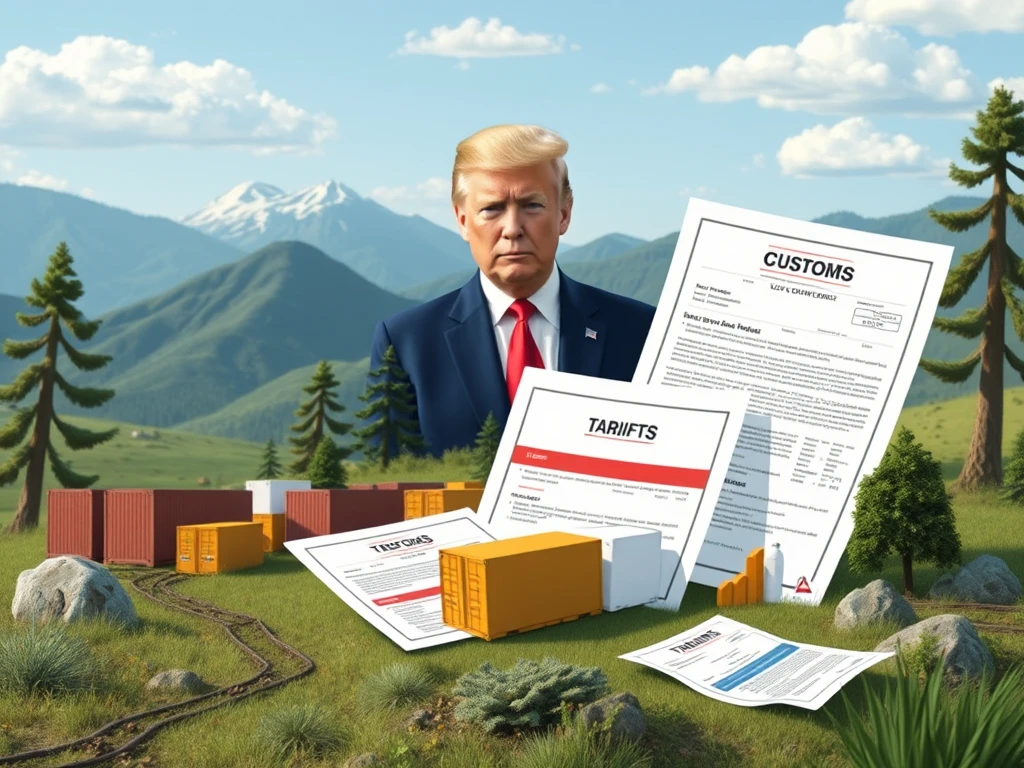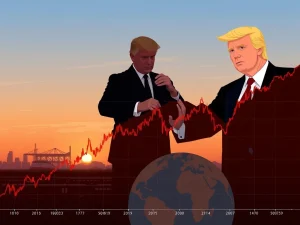Trump’s Revolutionary Tax Plan: Massive Cuts Via Tariffs Could Impact Crypto

For many interested in cryptocurrencies and the broader financial markets, shifts in government tax policy are a major point of focus. Recently, United States President Donald Trump proposed a significant overhaul of the U.S. tax system, suggesting that the federal income tax could be substantially reduced or even eliminated. This radical idea hinges on replacing the current tax revenue with funds generated from import tariffs. But what exactly does this mean, and how might it affect everything from your wallet to the value of crypto assets?
Trump’s Vision: Eliminating the Federal Income Tax
President Trump has openly discussed a plan to drastically alter how the U.S. government collects revenue. The core idea is to move away from the traditional federal income tax system, managed by the IRS, towards a model primarily funded by import duties or tariffs.
In recent statements, Trump indicated that under this proposed system, federal taxes would be 'substantially reduced,' with a particular focus on providing relief for individuals earning less than $200,000 annually. He even referenced the concept of an 'External Revenue Service,' implying a system where government funding comes exclusively from taxing imports rather than domestic income.
This isn't the first time Trump has floated this idea. He previously mentioned it during a campaign appearance, drawing parallels to the 19th-century Gilded Age in the U.S., a period before a permanent federal income tax was established. The argument is that relying on import duties could stimulate domestic production and return the U.S. to a past era of prosperity.
Potential Savings and Economic Impact of Reduced Taxes
If the federal income tax were indeed eliminated or significantly cut, the financial implications for American taxpayers could be substantial. Research cited by accounting automation company Dancing Numbers suggests that eliminating the federal income tax could save the average American over $134,000 in lifetime tax payments. If other wage-based taxes were also removed, the potential savings could climb even higher.
From an economic perspective, such a massive reduction in taxes could lead to a significant increase in disposable income for individuals and potentially lower costs for businesses (depending on how the tariff burden is distributed). This influx of capital into the economy is generally considered stimulative. Increased disposable income could lead to higher consumer spending and investment.
For asset markets, including crypto, a boost in disposable income could be a positive catalyst. With more money available after taxes, individuals might allocate a portion of it towards investments, potentially flowing into cryptocurrencies and other digital assets. However, this effect is not guaranteed and depends on various economic factors and investor confidence.
The Tariff Mechanism: How it Would Fund the Government
The other side of Trump's proposal involves the widespread implementation of tariffs. The concept is that revenue generated from taxing imported goods would replace the funds currently collected through the federal income tax system.
In early April, Trump signed an executive order that outlined sweeping tariffs, including a 10% baseline tariff on imports from all countries, with potentially higher 'reciprocal' rates on nations that tax U.S. goods. The idea is that foreign producers or consumers of foreign goods would bear the burden of funding the U.S. government, rather than American workers and businesses through income taxes.
However, the practical implementation and economic consequences of such a broad tariff regime are complex and debated. Tariffs can increase the cost of imported goods, potentially leading to higher prices for consumers (inflation) and increased costs for businesses relying on imported materials. They can also provoke retaliatory tariffs from other countries, hurting U.S. exports.
Market Skepticism and Challenges for the Plan
Despite the potential benefits of reduced federal income tax for individuals, Trump's tariff-funded plan has faced significant skepticism from analysts and markets. The primary concerns revolve around the feasibility and stability of relying solely on tariff revenue, as well as the negative impacts of protectionist trade policies.
Key challenges and criticisms include:
- Revenue Volatility: Tariff revenue can be highly volatile, depending on global trade volumes, economic conditions, and diplomatic relations. This makes it an unreliable sole source of funding for the federal government compared to the more stable income tax base.
- Economic Disruption: Widespread tariffs can disrupt supply chains, increase business costs, and lead to trade wars, negatively impacting economic growth and potentially offsetting any gains from tax cuts.
- Market Instability: Uncertainty surrounding trade policies has historically led to increased volatility in stock markets and fluctuations in bond yields, creating an unpredictable environment for investors.
- Flip-Flopping Policies: The Trump administration's past instances of frequently changing rhetoric and implementation timelines regarding tariffs have heightened this uncertainty and drawn criticism from financial experts.
Financial analysts argue that while the goal of reducing the tax burden is popular, the proposed method of funding through extensive tariffs could ultimately harm capital markets and achieve little in terms of sustainable economic benefit.
What This Means for Crypto and Beyond
While the direct impact of a shift from federal income tax to tariffs on crypto is indirect, the potential increase in disposable income and the broader economic environment are relevant. If the plan were successfully implemented and led to genuine economic growth and increased investment capital, assets like crypto could potentially benefit.
However, the significant doubts and potential negative consequences highlighted by critics — such as trade wars, inflation, and market instability — could create a challenging environment for all asset classes, including digital ones. The outcome depends heavily on the specifics of the plan, how it's implemented, and the global response.
Conclusion: A Bold, Yet Uncertain, Tax Proposal
Donald Trump's proposal to substantially reduce or eliminate the federal income tax, funding the government instead through import tariffs, is a revolutionary concept with potentially massive implications. While the prospect of significant tax savings for individuals is appealing and could theoretically boost investment in assets like crypto, the plan faces considerable hurdles. The reliance on volatile tariff revenue and the potential for economic disruption from widespread trade barriers raise serious questions about its feasibility and overall benefit. As discussions around this plan continue, market participants and taxpayers alike will be watching closely to understand the true potential impact on the U.S. economy and their own financial futures.









